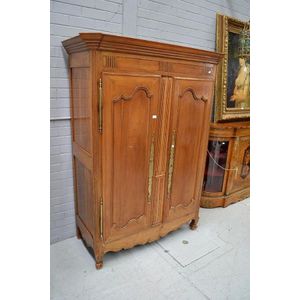1820's North German Birch Corner Cabinet
Antique North German bow front satin birch corner cabinet, circa 1820's, approx. height 213 cm, width 150 cm
You must be a subscriber, and be logged in to view price and dealer details.
Subscribe Now to view actual auction price for this item
When you subscribe, you have the option of setting the currency in which to display prices to $Au, $US, $NZ or Stg.
This item has been sold, and the description, image and price are for reference purposes only.
- Bow Front - The front is shaped in a gentle curve or bow. Introduced during the 18th century, the bow-front is associated with furniture of the Hepplewhite and Sheraton period, though of course the form continued to be used throughout the 19th century. Bow-fronted pieces are usually veneered, although some were cut from the solid wood. Where veneer is used, the carcase is cut either from pine or deal, or sometimes the front was built up and shaped with small timber 'bricks'. Commonly used on various types of furniture including chairs, settees, chests, side tables, sideboards and display cabinets.
- Birch - Birch is a Northern Hemisphere hardwood, closely related to the beech/oak family, and was a timber popular with 18th century craftsmen. Because of the blonde-golden colour of the grain when polished and its close grain, as a veneer it is often used as a substitute for satinwood where cost savings are required. From the late 18th century cabinetmakers in Russia and Eastern Europe used it in the solid for chairs and other furniture.
Karelian birch is birch with a burr grain that resembles marble, from the Karelia region between Finland and Russia. Because only 30% to 40% of seeds result in trees with Karelian birch features, and the fact that it is very slow growing, the timber is very expensive. - Circa - A Latin term meaning 'about', often used in the antique trade to give an approximate date for the piece, usually considered to be five years on either side of the circa year. Thus, circa 1900 means the piece was made about 1900, probably between 1895 and 1905. The expression is sometimes abbreviated to c.1900.
This item has been included into following indexes:
Visually similar items

19th century huon pine combination wardrobe, hanging space to one side, drawers to the other
Sold by
in
for
You can display prices in $Au, $US, $NZ or Stg.

Antique French Louis XV style walnut armoire, approx 194 cm high, 143 cm wide
Sold by
in
for
You can display prices in $Au, $US, $NZ or Stg.

Antique 19th century French Louis XV armoire, walnut and oak, inlaid decoration to the crest, and shaped apron below. Approx 245 cm high, 152 cm wide, 52 cm deep
Sold by
in
for
You can display prices in $Au, $US, $NZ or Stg.

Cedar wardrobe with drawer in base & Gothic pelmet
Sold by
in
for
You can display prices in $Au, $US, $NZ or Stg.
